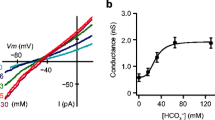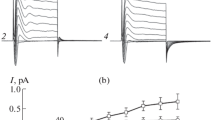Abstract
The rectal gland of the dogfish (Squalus acanthias) secretes chloride via a chloride channel present in the apical cell membrane. Using the patch clamp technique in isolated perfused rectal gland tubules [7], two types of chloride channels are demonstrable in the apical membrane of cyclic AMP treated tubule segments. A small channel of about 11 pS and another channel of 40–50 pS are present. The small channel is described in the succeeding report. With NaCl on both sides (excised patches) the current amplitude of the larger channel is an almost linear function of the voltage (±50 mV). However, the open probability of this channel is grossly reduced at negative clamp potentials (corresponding to cell hyperpolarization). Therefore, the macroscopic Cl− current through this channel is reduced with hyperpolarization on the cytosolic side. An analysis of time constants of this channel reveals that at depolarized voltages two open and two closed time constants of about 1 ms and of about 10 ms, respectively, are demonstrable. With hyperpolarized voltages the larger open state time constant is reduced significantly. This type of chloride channel is blocked reversibly by diphenylamine-2-carboxylate (10−4 mol/l) and by 5-nitro-2-(3-phenylpropylamino)-benzoate (10−5 mol/l). The channel is selective for Cl− over Na− and K− as well as over Br−. It is, however, permeable for NO -3 . Since this channel is very rare or absent in nonstimulated rectal gland tubules, it is very likely that this type of channel is responsible for hormone and cAMP dependent chloride secretion in this organ.
Similar content being viewed by others
References
Blatz L, Magleby KL (1983) Single voltage-dependent chlorideselective channels of large conductance in cultured rat muscle. Biophys J 43:237–241
Chesnoy-Marchais D, Evans MG (1984) Two types of chloride channels in outside-out patches from Aplysia neurones. J Physiol 357:64P
DiStefano A, Wittner M, schlatter E, Lang HJ, Englert H, Greger R (1985) Diphenylamine-2-carboxylate, a blocker of the Cl−-conductive pathway in Cl−-transporting epithelia. Pflügers Arch (Suppl 1):S95-S100
Epstein FH (1979) The shark rectal gland: a model for the active transport of chloride. Yale J Biol Med 52:517–523
Geletyuk VI, Kazachenko VN (1985) Single Cl− channels in melluscan neurones: multiplicity of the conductance states. J Membr Biol 86:9–15
Gögelein H, Greger R (1986) A voltage-dependent channel in the basolateral membrane of late proximal tubules of the rabbit kidney. Pflügers Arch (Suppl 2): S142-S148
Greger R, Schlatter E (1984) Mechanism of NaCl secretion in the rectal gland of spiny dogfish (Squalus acanthias). I. Experiments in isolated in vitro perfused rectal gland tubules. Pflügers Arch 402:63–75
Greger R, Schlatter E (1984) Mechanism of NaCl secretion in rectal gland tubules of spiny dogfish (Squalus acanthias). II. Effects of inhibitors. Pflügers Arch 402:364–375
Greger R, Schlatter R, Wang F, Forrest JN Jr (1984) Mechanism of NaCl secretion in rectal gland tubules of spiny dogfish (Spualus acanthias). III. Effects of stimulation of secretion by cyclic AMP. Pflügers Arch 402:376–384
Greger R, Schlatter E, Gögelein H (1985) Cl− channels in the apical cell membrane of the rectal gland “induced” by cAMP. Pflügers Arch 403:446–448
Gögelein H, Schlatter E, Greger R (1987) The “small” conductance chloride channel in the luminal membrane of the rectal gland of the dogfish (Squalus acanthias). Pflügers Arch 409:122–125
Greger R, Gögelein H, Schlatter E (1987) Potassium channels in the basolateral membrane of the rectal gland of the dogfish (Squalus acanthias). Pflügers Arch 409:100–106
Halm D, Rechkemmer G, Frizzell R (1986) Single-channel recording from a secretory epithelial cell line, T84. Fed Proc 45:741
Hamill OP, Marty A, Neher E, Sakmann B, Sigworth FJ (1981) Improved patch-clamp techniques for high-resolution current recording from cells and cell-free membrane patches. Pflügers Arch 391:85–100
Hanrahan JW, Alles WP, Lewis SA (1985) Single anionselective channels in basolateral membrane of a mammalian tight epithelium. Proc Natl Acad Sci USA 82:7791–7795
Kolb HA, Brown CDA, Murer H (1985) Identification of a voltage-dependent anion channel in the apical membrane of a Cl−-secretory epithelium (MDCK). Pflügers Arch 403:262–265
Krouse ME, Schneider GT, Gage PW (1986) A large anionselective channel has seven conductance levels. Nature 319:58–60
Miller C (1982) Open-state substructure of single chloride channels from Torpedo electroplax. Philos Trans R Soc Lond B299:401–414
Nelson DJ, Tang JM, Palmer LG (1984) Single-channel recordings of apical membrane chloride conductance in A6 epithelial cells. J Membr Biol 80:81–89
schneider GT, Cook DI, Gage PW, Young JA (1985) Voltage sensitive, high-conductance chloride channels in the luminal membrane of cultured pulmonary alveolar (type II) cells. Pflügers Arch 404:354–357
Shoemaker RL, Frizzell RA, Dwyer TM, Farley JM (1986) Single chloride channel currents from canine tracheal epithelial cells. Biochim Biophys Acta 858:235–242
Sigworth F (1983) An example of analysis. In: Sakmann B, Neher E (eds) Single channel recording. Plenum Press, New York London, pp 301–322
Silva P, Stoff J, Field M, Fine L, Forrest JN, Epstein FH (1977) Mechanism of active chloride secretion by shark rectal gland: role of Na-K-ATPase in chloride transport. Am J Physiol 233(4):F298-F306
Wangemann P, Wittner M, DiStefano A, Englert HC, Lang HJ, Schlatter E, Greger R (1986) Cl−-channel blockers in the thick ascending limb of the loop of Henle. Structure activity relationship. Pflügers Arch 407 (Suppl 2):S128-S141
Welsh MJ (1986) Single apical membrane anion channels in primary cultures of canine tracheal epithelium. Pflügers Arch 407 (Suppl 2):S116-S122
Author information
Authors and Affiliations
Additional information
Supported by Deutsche Forschungsgemeinschaft Gr 480 and by NSF and NIH grants to the MDIBL
Rights and permissions
About this article
Cite this article
Greger, R., Schlatter, E. & Gögelein, H. Chloride channels in the luminal membrane of the rectal gland of the dogfish (Squalus acanthias). Pflugers Arch. 409, 114–121 (1987). https://doi.org/10.1007/BF00584757
Received:
Accepted:
Issue Date:
DOI: https://doi.org/10.1007/BF00584757




